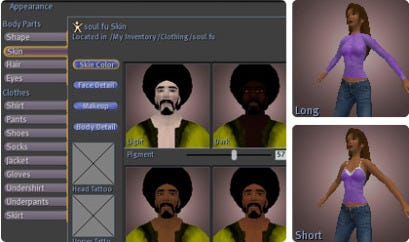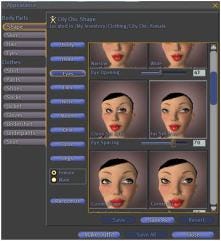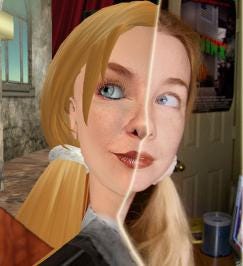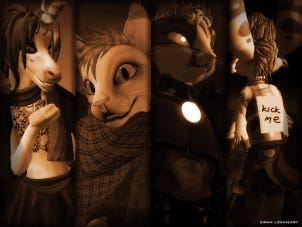Boobs, Muscles & Fairy Wings: Everything I Know About How Humans Design Their Avatar Selves
It was a mixture of early career anxiety and actual startup struggles that made my years working on Second Life stressful. I remember my parents visiting our office and casting a sideways glance at the bottles of Mylanta and hard alcohol sitting side by side on my desk, like a cartoon angel and devil on the shoulders of an 80s movie character wrestling with his conscience. In hindsight, though, the tremendous benefits of the experience are clear — I had the opportunity to work on a thoughtful, innovative product with an amazing technical team and together, we produced what is ultimately an ongoing, profitable company (even if it failed to achieve its full potential).
Besides the meta-learnings about how startups function, there were a [NeesonVoice] very particular set of skills [/NeesonVoice] I took away from my years at Linden Lab. The other day, a young entrepreneur — she was in diapers when we started Second Life — asked me about avatars and specifically, the design decisions we made about how people could represent themselves in our virtual world. It was so much fun reminiscing about what we observed that I wanted to document some stuff here. Caveats: This was 2001–2003 for me, so some memories might be hazy or inaccurate — and although I’m writing this post, I’m not taking “credit” for the underlying work. Early SL had an amazing founder, and a superior multidisciplinary team — everything here is at best “we,” and mostly “they,” in terms of what we built.
A Very Brief Overview of the Original SL Avatar System


Your basic form had to be humanoid — but within that, you could tune a ton of parameters using slider bars. Textures could be applied to your body as clothing, skins, and so on. You also had multiple “attach points,” perhaps best understood as the geometric points on your head, shoulders, chest, groin, and so on, to which you could stick other objects. So if, for example, you wanted to wear a Mickey Mouse costume, you would design your avatar however you wanted, and the costume itself would be an outfit applied to these attach points.
People Don’t Like Getting Dressed in Public
Since there wasn’t a way to truly be “offline” in Second Life (it was a fully immersive streamed world), we needed a way to convey that users were in the process of modifying their avatars. Users were very nervous about changing in public, and what onlookers might see — their virtual selves in a stage of disrobing? What if they made a mistake, or were shown changing from one self to another, experimenting with gender, sexuality, etc.? Since it wasn’t just about your clothing — your entire form was malleable — the act of “dressing” was, in some ways, even more vulnerable than it might be on the streets of San Francisco, despite the “virtual” nature of the world. But how to convey privacy to new users?
We tried a variety of mechanisms, some more successful than others. The team eventually settled on a very literal representation: the changing room/privacy screen. A user altering their avatar was surrounded by a box so that no one could see what they were doing. We realized this made it hard to ask your friends for feedback on your outfit, so we ended up with a hybrid privacy mode and “dressing pose” (in which your avatar stands still with its arms and legs open).
Despite the demand for privacy, everyone took off all their clothes at some point to see what happened. Spoiler: no genitals. But creative users found ways to use attach points to, uh, “fix” that. Sigh.
(Thanks to Cory and James for the refreshers on this one.)
The “Who Am I” Decision Tree





In a world where you can “be” anyone, what do you want to look like? Some people had a fixed appearance and rarely deviated, while others tried on new personas daily. New users, especially those unfamiliar with avatar construction from RPGs, usually went down this decision tree:
- Photorealistic? (Those realistic-looking cartoon avatars that are becoming increasingly popular on social media)
- If photorealistic, based on my appearance, or someone else’s?
- If not photorealistic, then aspirational, exploratory, or extreme?
Aspirational: Tall, with large breasts or muscles (or both)
Exploratory: A regular human, but unlike yourself — exploring different genders, ages, and body types (fat, thin)
Extreme: What happens if I just drag the sliders to random extremes and run around the world like that?


Teens Like to Explore Identities
You know who really liked exploring identities in anonymity? Teens! We eventually had to create a Teen Grid, a version of Second Life only open to 13–17 year olds with their parents’ permission. I was struck by the malleability of their identities at first, but it made perfect sense as I read more about their IRL developmental stages. Caught between “kid” and “adult,” and wanting to explore both at once. Expanding beyond your immediate social circle and geography. Finding connections and differences. Understanding your sexuality for the first time. Imagine being able to try all of that on like an outfit?
Can’t Be Too Big (or Too Small)
We limited avatar height because of the prisoner’s dilemma: everyone would want to be a huge dragon. Our height minimum was originally to ensure you were generally visible in the world — no Ant-Man in Second Life. But we eventually increased the height minimum to the size of a small adult. Why? To attempt to prevent kiddie porn roleplay. Ugh, right? I’m serious though. If you let people make child avatars, they’re gonna do some disgusting shit. It was against our Terms of Service, obviously — even though there was, and continues to be, legal grey area when it comes to pornography that doesn’t depict actual people — but the team decided it shouldn’t even be possible.
(Note: This is the way I remember it, but I found other accounts which suggest child avatars were allowed, but were heavily limited in terms of what they could do, according to our ToS. Either way, age play had its issues and avatar height played a role in that. Update: Cory, Linden’s founding CTO, reminded me that it was laws in Germany which helped guide some of our decisions here.]
Don’t Stand So Close to Me
Nick Yee did a ton of work on avatar interactions in virtual environments, discovering that we tend to carry over the same social space etiquette: standing the same distance from each other virtually that we would stand from a person IRL, or moving closer to “hear” someone — even if there were no spatial audio, but text chat. And so on.
Want Free Shit? Present as Female
This could also read “Want harassment?” given the history of misogyny within certain gaming communities, but I’ll focus on a different aspect of gender in Second Life. To paraphrase Nick Yee, female avatars are more likely to get assistance and free stuff from other in-game players, and Second Life was no exception. Gender determines so much about how we treat each other that, even in an avatar world, where there’s no way of knowing who someone really is, we default to whatever IRL norms we’re used to. Wild, right?
When Looks Are Just 1s and 0s, You Can Study Lots of Cool Stuff
During my years at Second Life, we didn’t have enough players to do really interesting research on avatars. But with a big enough sample size, it’s possible to calculate a ton of things quite trivially: what does the “average” avatar look like over time? What do avatars from different countries look like — do Brazilians create different avatars than Americans, than the Japanese? How do we choose to represent ourselves and are there general trends in the population which can be extracted?
Like I said, this is just what I remember from my Second Life years. I’m sure there are lots of accounts floating around out there which go into greater depth about how the avatar system changed over time, and the resulting learnings. If you see anything, just tweet at me, and I’ll try to add the links here.
